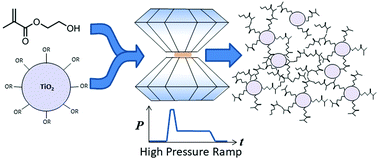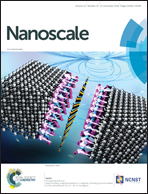Synthesis of organic–inorganic hybrids via a high-pressure-ramp process: the effect of inorganic nanoparticle loading on structural and photochromic properties†
Abstract
Organic polymerization remains a limiting step in the preparation of organic–inorganic hybrid materials with a strong concentration of the inorganic component. In this work, a high-pressure-ramp process was applied to achieve pHEMA–TiO2 nanoparticulate solids with an unprecedentedly high concentration (12 mol l−1) of the inorganic component, which is four times higher than that obtained after radical polymerization induced thermally or by photons. The inorganic nanoparticles underwent morphological and structural changes with an increase of Ti concentration above 1.5 mol l−1: they slightly coarsen and crystallize into an anatase polymorph. The material possesses a strong photochromic response related to the electron–hole separation at the organic–inorganic interface and can store 1e− per 5 Ti atoms. The electron storage capacity of the titania nanoparticles decreases upon crystallization.



 Please wait while we load your content...
Please wait while we load your content...